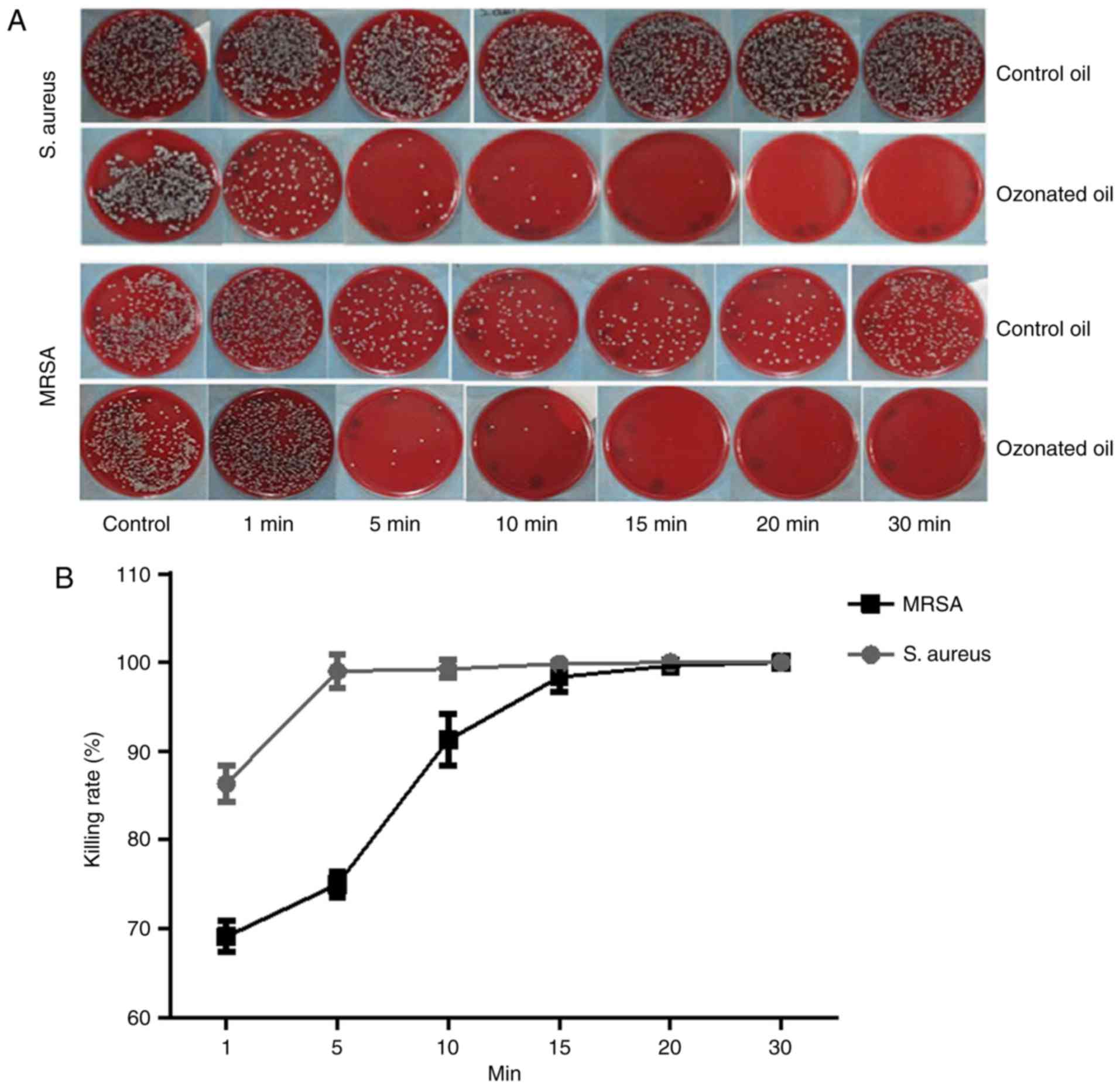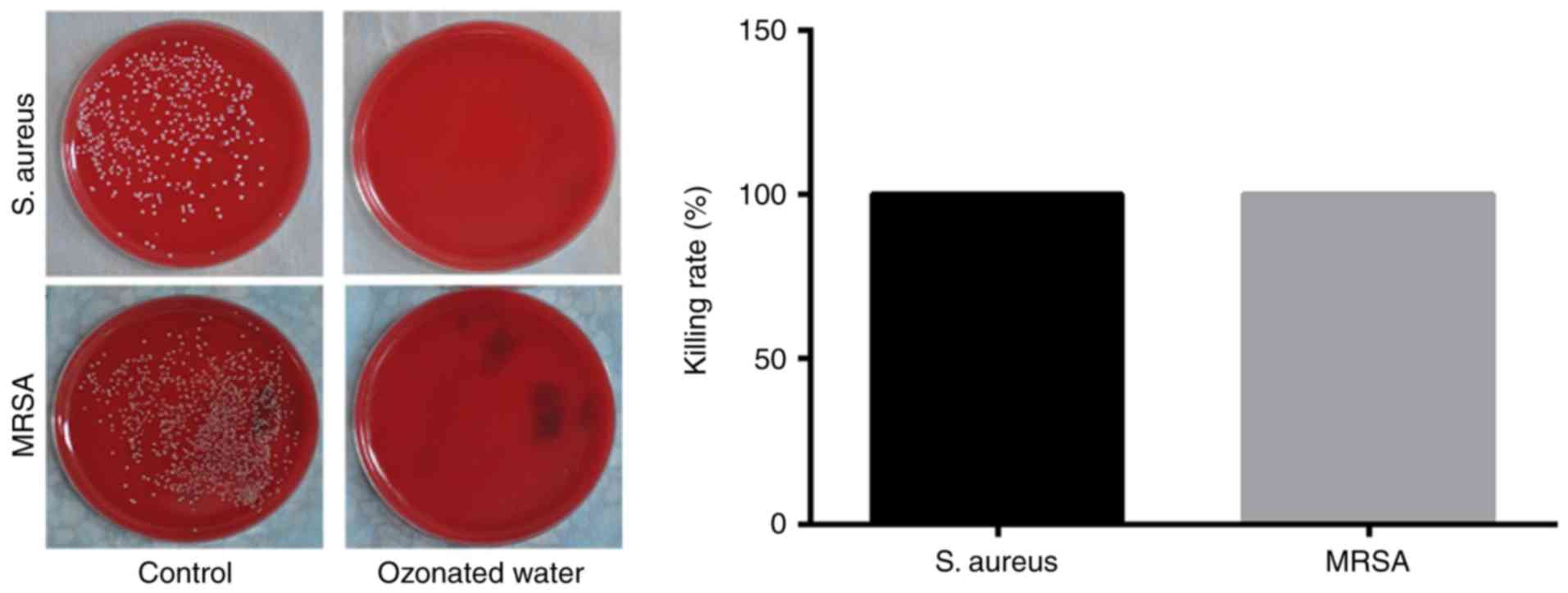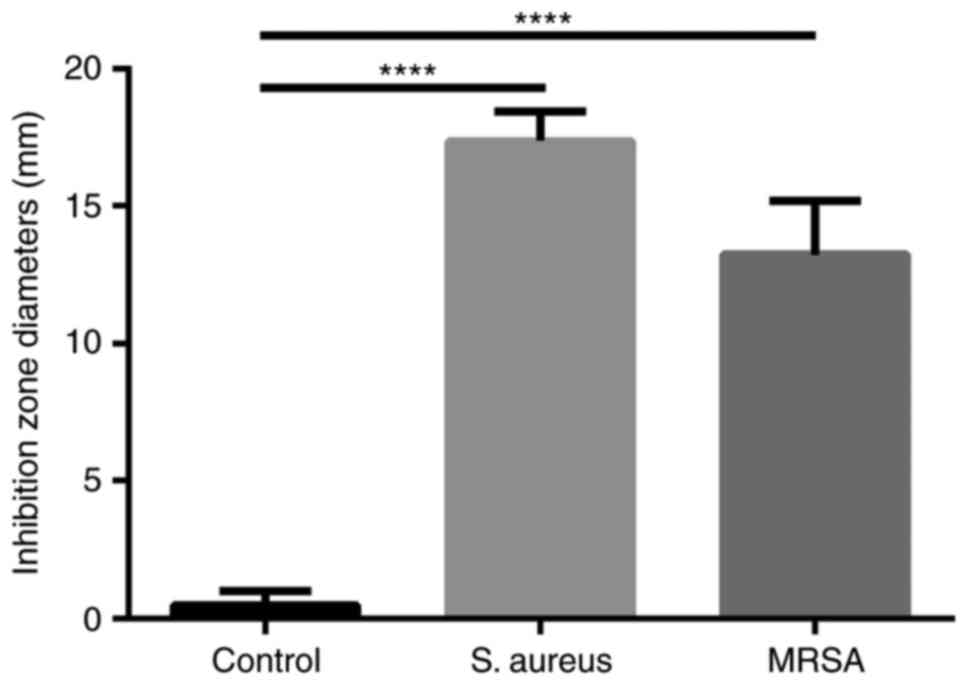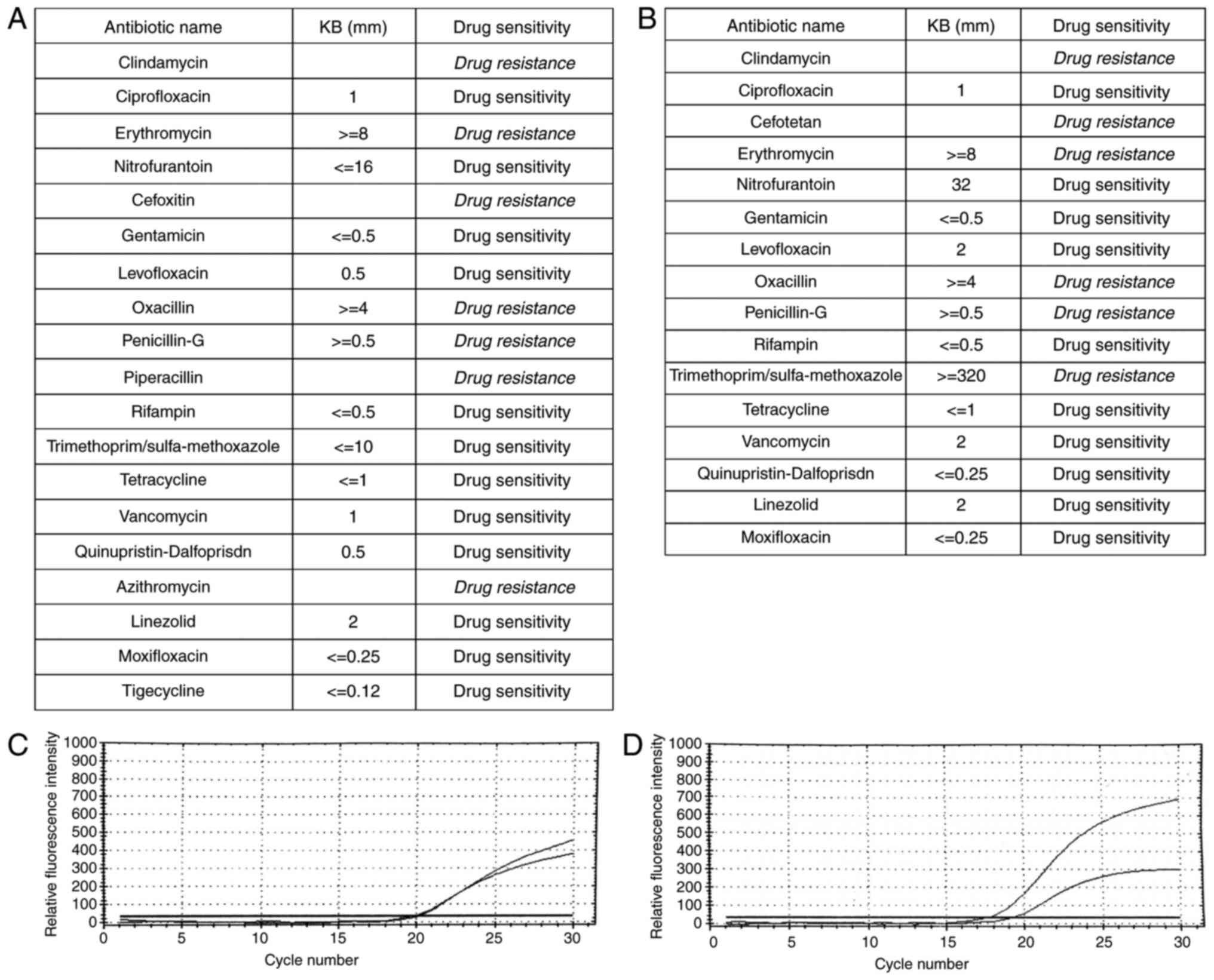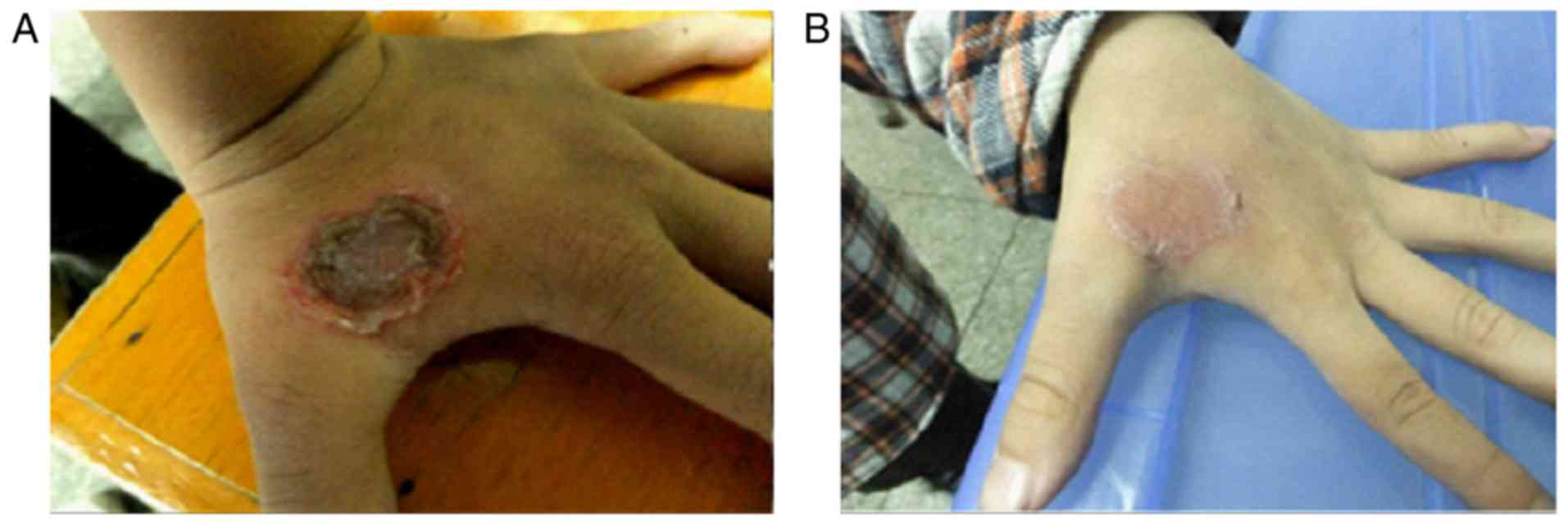|
1
|
Dréno B, Araviiskaia E, Berardesca E,
Gontijo G, Sanchez Viera M, Xiang LF, Martin R and Bieber T:
Microbiome in healthy skin, update for dermatologists. J Eur Acad
Dermatol Venereol. 30:2038–2047. 2016. View Article : Google Scholar : PubMed/NCBI
|
|
2
|
Diaz JH and Lopez FA: Skin, soft tissue
and systemic bacterial infections following aquatic injuries and
exposures. Am J Med Sci. 349:269–275. 2015. View Article : Google Scholar : PubMed/NCBI
|
|
3
|
Sully EK and Geller BL: Antisense
antimicrobial therapeutics. Curr Opin Microbiol. 33:47–55. 2016.
View Article : Google Scholar : PubMed/NCBI
|
|
4
|
Yang X, Zhang J, Yu S, Wu Q, Guo W, Huang
J and Cai S: Prevalence of Staphylococcus aureus and
methicillin-resistant Staphylococcus aureus in retail ready-to-eat
foods in China. Front Microbiol. 7:8162016. View Article : Google Scholar : PubMed/NCBI
|
|
5
|
Miller WR, Bayer AS and Arias CA:
Mechanism of action and resistance to daptomycin in Staphylococcus
aureus and enterococci. Cold Spring Harb Perspect Med. 6:pii:
a0269972016. View Article : Google Scholar
|
|
6
|
Greene AK, Few BK and Serafini JC: A
comparison of ozonation and chlorination for the disinfection of
stainless steel surfaces. J Dairy Sci. 76:3617–3620. 1993.
View Article : Google Scholar : PubMed/NCBI
|
|
7
|
Fiessinger F, Richard Y, Montiel A and
Musquere P: Advantages and disadvantages of chemical oxidation and
disinfection by ozone and chlorine dioxide. Sci Total Environ.
18:245–261. 1981. View Article : Google Scholar : PubMed/NCBI
|
|
8
|
Stalder K and Klosterkötter W: Studies on
the reappearing of a bacterial flora in drinking water after
ozonization (author's transl). Zentralbl Bakteriol Orig B.
161:474–481. 1976.(In German). PubMed/NCBI
|
|
9
|
Liu J, Zhang P, Tian J, Li L, Li J, Tian
JH and Yang K: Ozone therapy for treating foot ulcers in people
with diabetes. Cochrane Database Syst Rev: Cd008474. 2015.
View Article : Google Scholar
|
|
10
|
Bassi P, Sbrascini S, Mattassi R, D'Angelo
F and Franchina A: Ozone in the treatment of herpes zoster. Riv
Neurobiol. 28:328–333. 1982.(In Italian). PubMed/NCBI
|
|
11
|
Moureu S, Violleau F, Ali Haimoud-Lekhal D
and Calmon A: Ozonation of sunflower oils: Impact of experimental
conditions on the composition and the antibacterial activity of
ozonized oils. Chem Phys Lipids. 186:79–85. 2015. View Article : Google Scholar : PubMed/NCBI
|
|
12
|
Zhong J, Allen K, Rao X, Ying Z,
Braunstein Z, Kankanala SR, Xia C, Wang X, Bramble LA, Wagner JG,
et al: Repeated ozone exposure exacerbates insulin resistance and
activates innate immune response in genetically susceptible mice.
Inhal Toxicol. 28:383–392. 2016. View Article : Google Scholar : PubMed/NCBI
|
|
13
|
Farac RV, Pizzolitto AC, Tanomaru JM,
Morgental RD, Lima RK and Bonetti-Filho I: Ex-vivo effect of
intracanal medications based on ozone and calcium hydroxide in root
canals contaminated with Enterococcus faecalis. Braz Dent J.
24:103–106. 2013. View Article : Google Scholar : PubMed/NCBI
|
|
14
|
Heß S and Gallert C: Sensitivity of
antibiotic resistant and antibiotic susceptible Escherichia coli,
Enterococcus and Staphylococcus strains against ozone. J Water
Health. 13:1020–1028. 2015. View Article : Google Scholar : PubMed/NCBI
|
|
15
|
Sharma M and Hudson JB: Ozone gas is an
effective and practical antibacterial agent. Am J Infect Control.
36:559–563. 2008. View Article : Google Scholar : PubMed/NCBI
|
|
16
|
Gadzhiev ND, Nasirov Mla, Sushkov SV and
Klimova EM: Effect of combined and local cytokine- and ozone
therapy on the indices of lipid peroxidation, endogenous
intoxication and ferroproteins in diffuse peritonitis. Vestn Khir
Im I I Grek. 173:38–41. 2014.(In Russian). PubMed/NCBI
|
|
17
|
Kolesova OE, Vasil'ev IT, Volkhovskaia NB,
Mumladze RB, Tkachenko SB and Savina GD: Correction of the
antioxidative system during ozone therapy in peritonitis. Vestn
Ross Akad Med Nauk. 34–39. 2010.(In Russian). PubMed/NCBI
|
|
18
|
Tamai M, Matsushita S, Miyanohara H, Imuta
N, Ikeda R, Kawai K, Nishi J, Sakamoto A, Shigihara T and Kanekura
T: Antimicrobial effect of an ultrasonic levitation washer
disinfector with silver electrolysis and ozone oxidation on
methicillin-resistant Staphylococcus aureus. J Dermatol.
40:1020–1026. 2013. View Article : Google Scholar : PubMed/NCBI
|
|
19
|
Solovăstru LG, Stîncanu A, De Ascentii A,
Capparé G, Mattana P and Vâţă D: Randomized, controlled study of
innovative spray formulation containing ozonated oil and
α-bisabolol in the topical treatment of chronic venous leg ulcers.
Adv Skin Wound Care. 28:406–409. 2015. View Article : Google Scholar : PubMed/NCBI
|
|
20
|
Gulmen S, Kurtoglu T, Meteoglu I, Kaya S
and Okutan H: Ozone therapy as an adjunct to vancomycin enhances
bacterial elimination in methicillin resistant Staphylococcus
aureus mediastinitis. J Surg Res. 185:64–69. 2013. View Article : Google Scholar : PubMed/NCBI
|
|
21
|
Al-Saadi H, Potapova I, Rochford ET,
Moriarty TF and Messmer P: Ozonated saline shows activity against
planktonic and biofilm growing Staphylococcus aureus in vitro: A
potential irrigant for infected wounds. Int Wound J. 13:936–942.
2016. View Article : Google Scholar : PubMed/NCBI
|
|
22
|
Wilczyńska-Borawska M, Leszczyńska K,
Nowosielski C and Stokowska W: Ozone in dentistry: Microbiological
effects of gas action depending on the method and the time of
application using the ozonytron device. Experimental study. Ann
Acad Med Stetin. 57:99–103. 2011.PubMed/NCBI
|
|
23
|
Yamayoshi T and Tatsumi N: Microbicidal
effects of ozone solution on methicillin-resistant Staphylococcus
aureus. Drugs Exp Clin Res. 19:59–64. 1993.PubMed/NCBI
|
|
24
|
Almaz ME and Sönmez IŞ: Ozone therapy in
the management and prevention of caries. J Formos Med Assoc.
114:3–11. 2015. View Article : Google Scholar : PubMed/NCBI
|
|
25
|
Komanapalli IR and Lau BH: Inactivation of
bacteriophage lambda, Escherichia coli, and Candida albicans by
ozone. Appl Microbiol Biotechnol. 49:766–769. 1998. View Article : Google Scholar : PubMed/NCBI
|
|
26
|
Gierek-Lapińska A, Antoszewski Z, Myga B
and Skowron J: Preliminary report on using therapeutic ozone in
infectious conjunctivitis and keratitis and in corneal
degeneration. Klin Oczna. 94:137–138. 1992.(In Polish). PubMed/NCBI
|
|
27
|
Erginel B, Erginel T, Aksoy B and Dokucu
AI: Effect of Ozone Therapy (OT) on healing of colonic anastomosis
in a rat model of peritonitis. Balkan Med J. 31:249–253. 2014.
View Article : Google Scholar : PubMed/NCBI
|
|
28
|
Parkhisenko IuA and Glukhov AA: Use of
ozone therapy and hydro-pressure technologies in complex intensive
therapy of surgical sepsis. Khirurgiia (Mosk). 55–58. 2001.(In
Russian). PubMed/NCBI
|
|
29
|
Verrazzo G, Coppola L, Luongo C,
Sammartino A, Giunta R, Grassia A, Ragone R and Tirelli A:
Hyperbaric oxygen, oxygen-ozone therapy, and rheologic parameters
of blood in patients with peripheral occlusive arterial disease.
Undersea Hyperb Med. 22:17–22. 1995.PubMed/NCBI
|
|
30
|
Bocci VA: Scientific and medical aspects
of ozone therapy. State of the art. Arch Med Res. 37:425–435. 2006.
View Article : Google Scholar : PubMed/NCBI
|
|
31
|
Zhang J, Guan M, Xie C, Luo X, Zhang Q and
Xue Y: Increased growth factors play a role in wound healing
promoted by noninvasive oxygen-ozone therapy in diabetic patients
with foot ulcers. Oxid Med Cell Longev. 2014:2734752014. View Article : Google Scholar : PubMed/NCBI
|
|
32
|
Kazancioglu HO, Kurklu E and Ezirganli S:
Effects of ozone therapy on pain, swelling, and trismus following
third molar surgery. Int J Oral Maxillofac Surg. 43:644–648. 2014.
View Article : Google Scholar : PubMed/NCBI
|
|
33
|
Noor S, Khan RU and Ahmad J: Understanding
diabetic foot infection and its management. Diabetes Metab Syndr.
11:149–156. 2017. View Article : Google Scholar : PubMed/NCBI
|
|
34
|
Kateel R, Adhikari P, Augustine AJ and
Ullal S: Topical honey for the treatment of diabetic foot ulcer: A
systematic review. Complement Ther Clin Pract. 24:130–133. 2016.
View Article : Google Scholar : PubMed/NCBI
|
|
35
|
Reveles KR, Duhon BM, Moore RJ, Hand EO
and Howell CK: Epidemiology of methicillin-resistant Staphylococcus
aureus diabetic foot infections in a large academic hospital:
Implications for antimicrobial stewardship. PLoS One.
11:e01616582016. View Article : Google Scholar : PubMed/NCBI
|
|
36
|
Gazin IK: Pathophysiological aspects of
endotoxicosis complicated with purulent infection of the foot and
correction of endotoxicosis with conventional treatment and with
application of ozonized physiological solution in patients
suffering from diabetes mellitus. Patol Fiziol Eksp Ter. 23–25.
2008.(In Russian). PubMed/NCBI
|
|
37
|
Martínez-Sánchez G, Al-Dalain SM, Menéndez
S, Re L, Giuliani A, Candelario-Jalil E, Alvarez H,
Fernández-Montequín JI and León OS: Therapeutic efficacy of ozone
in patients with diabetic foot. Eur J Pharmacol. 523:151–161. 2005.
View Article : Google Scholar : PubMed/NCBI
|
|
38
|
Al-Dalain SM, Martínez G, Candelario-Jalil
E, Menéndez S, Re L, Giuliani A and León OS: Ozone treatment
reduces markers of oxidative and endothelial damage in an
experimental diabetes model in rats. Pharmacol Res. 44:391–396.
2001. View Article : Google Scholar : PubMed/NCBI
|
|
39
|
Bialoszewski D, Pietruczuk-Padzik A,
Kalicinska A, Bocian E, Czajkowska M, Bukowska B and Tyski S:
Activity of ozonated water and ozone against Staphylococcus aureus
and Pseudomonas aeruginosa biofilms. Med Sci Monit. 17:BR339–BR344.
2011. View Article : Google Scholar : PubMed/NCBI
|
|
40
|
Burke FJ: Ozone and caries: A review of
the literature. Dent Update. 39:271–272, 275–278. 2012. View Article : Google Scholar : PubMed/NCBI
|
|
41
|
Valacchi G, Zanardi I, Lim Y, Belmonte G,
Miracco C, Sticozzi C, Bocci V and Travagli V: Ozonated oils as
functional dermatological matrices: Effects on the wound healing
process using SKH1 mice. Int J Pharm. 458:65–73. 2013. View Article : Google Scholar : PubMed/NCBI
|
|
42
|
Pai SA, Gagangras SA, Kulkarni SS and
Majumdar AS: Potential of ozonated sesame oil to augment wound
healing in rats. Indian J Pharm Sci. 76:87–92. 2014.PubMed/NCBI
|
|
43
|
Zhang YB, Xiang YP, Huang JH, Gao L, Chen
M, Kathy W, Li M, Chen J, Yang S and Lu J: Combined ozone
hydrotherapy for atopic dermatitis: Evaluation of efficacy and
detection of interleukin-4 and nerve growth factor levels in
peripheral blood from patients before and after treatment. Chin J
Dermatol. 49:736–738. 2016.(In Chinese).
|















